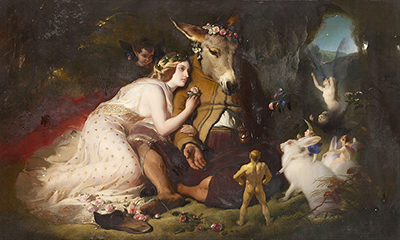This oil-on-canvas painting was executed in 1851 by British artist Edwin Henry Landseer. The work measures 32.3 by 52.4 inches, and the style that the artist used is called Romanticism. Since 1932, the painting has been in the National Gallery of Victoria (the NGV), an art museum situated in Melbourne, Victoria, Australia.
Landseer was well-known for his animal paintings, and this is his only work of a fairy scene. It depicts a scene from the from act 3 of A Midsummer Night's Dream written by William Shakespeare between 1595 and 1596. The painting shows Titania - who is the queen of the fairies in the play - after she was given a love potion and started to embrace the mechanical Nick Bottom, who was the object of her love temporarily. Nick has also been placed under a spell and has ass' head. Other fairy folks are observing them, with the scene decorated with rabbits and flowers.
This is one of the paintings of scenes from Shakespeare's works that were commissioned in 1847 by the British civil engineer Isambard Kingdom Brunel to embellish his dining room. The artist was paid 450 pounds to complete the work. Isambard gave the artist the freedom to choose the subject he prefered. Landseer decided to choose this scene so that he could include some animals in the painting. Other works that the artist produced were commissioned from Clarkson Frederick Stanfield, Charles Robert Leslie, Frederick Richard Lee, Augustus Egg and Charles West Cope.
The work was first exhibited in 1851 in the Summer Exhibition, and it was instantly a popular success. Queen Victoria praised in her diary. The English writer Charles Lutwidge Dodgson (Lewis Carroll) also praised the painting and admired the white rabbit. As such, the painting may have influenced Carroll to include a white rabbit in the 1865 novel that he wrote with the title Alice's Adventures in Wonderland.
In 1859, Brunel died and the work was sold in April 1860 at auction. Lord Robert Pelham-Clinton acquired the painting for 2,800 pounds. After the death of Lord Robert, Adelbert Wellington Brownlow - who was a courtier, soldier and Conservative politician - acquired the painting. It was later sold to the English Liberal/Liberal Unionist politician, stockbroker and art collector Sir William Cuthbert Quilter. Henry Lowenfeld purchased the painting in 1909 at auction for 2,400 pounds. This auction also included the 1854–1856 The Scapegoat by Holman Hunt. In 1931, after Lowenfeld's death, his widow sold it to the NGV, where it remains today.




